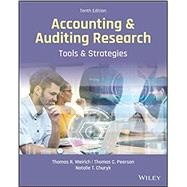Accounting and Auditing Research, 10th Edition prepares students and early-stage practitioners to use well-established research solutions in a broad range of practical applications, from financial accounting and tax planning, to investigating fraud and auditing various business problems. Emphasizing real-world skills development, this fully-updated textbook covers the current tools, techniques, and best practices in applied professional research and analysis.
The authors provide comprehensive yet accessible coverage of the entire research process, explaining how to utilize major research databases and audit software packages in a clear and systematic manner. The tenth edition features carefully revised content designed to enhance effectiveness, increase readability, and strengthen learning and retention. The book’s classroom-proven pedagogy features expert tips for performing common research tasks, sidebar boxes that summarize and expand upon key concepts, and a variety of end-of-chapter exercises that reinforce the material and develop readers’ skills.








